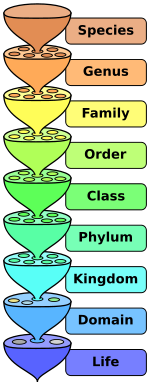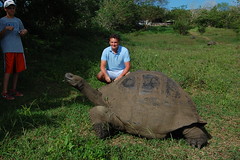 Tonight I learned more about classification, specifically Family and Order. This is in continuation of the book Basic Arithmetic which I started last week, part of the FUNDAEC course on Preparation for Social Action.
Tonight I learned more about classification, specifically Family and Order. This is in continuation of the book Basic Arithmetic which I started last week, part of the FUNDAEC course on Preparation for Social Action.
 Family is a higher level classification than genus, i.e. it is a superset of genara. The idea is that some genara are very similar, such as Canis (dog, coyote, wolf) and Vulpes (red fox, swift fox), as they share many common characteristics and probably only differ in a few. These can be grouped into a family called Canidae.
Family is a higher level classification than genus, i.e. it is a superset of genara. The idea is that some genara are very similar, such as Canis (dog, coyote, wolf) and Vulpes (red fox, swift fox), as they share many common characteristics and probably only differ in a few. These can be grouped into a family called Canidae.
The text continues in the manner which I am getting used to by now; interspersed in the lesson text are questions which are based on your current comprehension of the subject. They cause you to reflect on what you don’t yet know, and then answer the question in the next paragraph. This reflection and consequent group discussion, if your group pauses to answer the questions, really helps put the answers in perspective once you do get to them. It causes the process of learning to be an active one which involves the learners, rather than just listening to a set of facts. One has to be careful though to make sure the group discussions don’t get out of hand, as everyone may have an opinion on the answer, usually based on random incomplete prior knowledge of the subject matter, while the answer will be provided shortly.
Back to the chapter, we did some more set exercises grouping genera into families, and then were provided with a table of a few families with the instruction to examine and retain as much as possible of the information provided. This is interesting because the mode of instruction here is not one of forcing the student to memorize facts, but of providing the facts in context and allowing the student to retain as much as they naturally can, but also having them realize that they can always look back at this chapter or look up the information from other sources.
The questions continued as usual, talking about genara and families and their set/subset relationships, and then came a question about whether all human beings belong to the same family. This was an interesting diversion from the other questions about animals, because it suddenly brings into focus that in terms of species and animal-level classification constructs, we are really the same. We can all produce offspring therefore we are the same species, the most basic level of the hierarchy. But the question also evokes sentiments of belonging to the same family, with the traditional meaning of the word family (husband, wife and children).
Then came some more questions describing sets of animals and getting you to identify subset relationships, but this time the description was vague enough to encompass both dogs and cats, and bears and maybe even crocodiles. So we start to see that even family is not broad enough, and anticipate a higher level construct.
 This chapter then diverted attention in the reflection section to talk about another form of interaction between species, in addition to mutualism and commensalism – that of parasitism. This is where one organism benefits at the expense of the other. An example is given of the genus Plasmodium and of the four species within it that cause malaria. A detailed discussion then ensues on how malaria is transmitted through a certain genus of mosquito Anopheles, of the history of the fight against this disease, some tips on how to control its spread on a local level and a suggestion of how it could be done on a larger scale. This gets the participants to think about a particular problem (and an application of the concept of sets and of parasites) and how the problem could be solved. Our group talked about malaria a little, and I shared my story of having been sick with malaria many times a year while growing up in Cameroon, and of one occasion where I was hospitalized for a few days while they tried different series of malaria medication until they brought one from another town that finally worked.
This chapter then diverted attention in the reflection section to talk about another form of interaction between species, in addition to mutualism and commensalism – that of parasitism. This is where one organism benefits at the expense of the other. An example is given of the genus Plasmodium and of the four species within it that cause malaria. A detailed discussion then ensues on how malaria is transmitted through a certain genus of mosquito Anopheles, of the history of the fight against this disease, some tips on how to control its spread on a local level and a suggestion of how it could be done on a larger scale. This gets the participants to think about a particular problem (and an application of the concept of sets and of parasites) and how the problem could be solved. Our group talked about malaria a little, and I shared my story of having been sick with malaria many times a year while growing up in Cameroon, and of one occasion where I was hospitalized for a few days while they tried different series of malaria medication until they brought one from another town that finally worked.
Next, a shorter chapter on order. As a concept used for animal classification, an order consists of one or more families grouped together into a larger set which share common characteristics. An example would be the order Carnivora which includes the families Canidae and Felidae, which in turn include the genera Canis and Vulpes, and Panthera, Felis and Lynx. These in turn break down into the dog and wolf, red fox and swift fox, tiger and lion, domestic cat and wildcat, lynx and bobcat respectively.
One of the questions was a little confusing – it asked if there are orders with thousands of species. We thought, we don’t know, but it seems probably. Then it asked if there are orders with millions of species, then billions. Unsure of the biological facts, what does one answer? I guess knowing the infinite diversity of the universe one could assume that it is possible for there to be such a large range of species, but it seems unlikely that people would have spent that much time classifying so many species and grouping them all under orders. I guess we can always find out by doing some research on the internet, but the intent of the question seems to have been, as usual, to get you to think beyond the boundaries of your knowledge. And then another question about the human being, wether the order in which the human belongs contains only one family. Some people in the group were proposing that humans are entirely apart from animals in terms of classification because we belong to the human kindgom which is as distinct from the animal kingdom as the animal is from the vegetable. But on the other hand, scientific classification of animals could have grouped humans together with apes and other creatures with similar characteristics to us, at least in terms of our animalistic bodies.
 The reflection question was on the concept of endangered species, triggering thought on what factors contribute to a species being considered as endangered, and then describing some of the solutions that people and governments have come up with to the problem of endangered species. A positive example was given of the curbing of whaling by some nations, and how some whale species have made an amazing come-back. A further example was given of Charles Darwin visiting the Galapagos Islands and the subsequent history of the giant Galapagos tortoises over the years.
The reflection question was on the concept of endangered species, triggering thought on what factors contribute to a species being considered as endangered, and then describing some of the solutions that people and governments have come up with to the problem of endangered species. A positive example was given of the curbing of whaling by some nations, and how some whale species have made an amazing come-back. A further example was given of Charles Darwin visiting the Galapagos Islands and the subsequent history of the giant Galapagos tortoises over the years.
I never imagined I would learn so much about biology, which was one of my least favorite subjects in high school, but this is such a pleasant process that the information is somehow sinking in. I even dare to think it will be useful one day.
Next week: class, then phylum and kingdom.

One Comment
This integrative learning method is interesting for the spiritual principle underlying it.
Thank you for sharing!